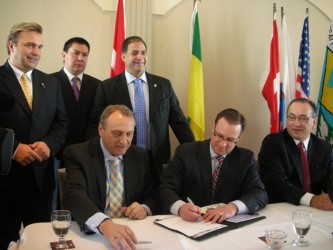Article Origin
Volume
Issue
Year
Five of Saskatchewan’s tribal councils have signed a Memorandum of Understanding with the federal and provincial governments where all parties agree to work together to increase First Nations participation in the province’s labour force.
Minister of Indian Affairs, John Duncan, joined Saskatchewan’s Minister of Advanced Education, Employment and Immigration, Rob Norris, along with the chiefs of Saskatoon Tribal Council, Meadow Lake Tribal Council, Agency Chiefs Tribal Council, Yorkton Tribal Council and File Hills Qu’Appelle Tribal Council in Saskatoon earlier this month for the ceremony.
Duncan said there are five ways the “Active Measures” MOU will help people get meaningful employment and off of Social Assistance.
“By providing greater access to career planning, skills development and employment counseling services; by providing greater access to literacy, adult education...by providing transitional supports such as training allowances...by providing supports such as transportation and childcare; and finally by working with employers and industry to align skills training with the demands of the labour market and economy,” he said.
STC Tribal Chief Felix Thomas said there are major cost savings to investing in First Nations youth now to make sure they get good jobs rather than being dependent on income assistance.
“When we look at the cost savings of getting a young person off Social Assistance, you know we save four or five thousand dollars a year. But, you know what our benefit is? Forty to fifty thousand dollars a year when that young individual participates in the economy,” he said.
MLTC Tribal Chief Eric Sylvestre said leaders have been asking themselves how to break the cycle of dependency, and added that while they haven’t found all the answers, different levels of government coming together is a good start.
But, he said, there still needs to be a closer look at on-reserve education.
“If we are expected to deliver curriculum to meet provincial standards, then we need to be funded at the provincial funding levels,” Sylvestre added.
As one of the young chiefs in the province, ACTC Tribal Chief Steven Jim said he sees the importance in looking for answers in First Nations communities and says education and training are key, as well as finding and creating jobs on-reserve.
“Bringing those employments home to our communities – a lot of our people don’t want to leave our communities, and I think it’s important we recognize that and try to bring employment home,” he said.
Although not all Saskatchewan tribal councils were there for the signing ceremony, Federation of Saskatchewan Indian Nations Chief Guy Lonechild pointed out that it is an open MOU, and he expects other tribal councils to sign up soon.
“I know Prince Albert Grand Council, which represents thirty-three per cent of our First Nations. There’s a lot of opportunities in northern Saskatchewan. We’d like to see those types of partnerships with industry and increase the job numbers in this province,” Chief Lonechild said.
Norris says this MOU is of benefit to the whole province, not just First Nations.
“First Nations participation in our economic development is not an option: it’s an imperative,” he said.
An Active Measures Steering Committee will be formed to ensure the implementation of this MOU.
Photo Caption: Back Row: Saskatchewan First Nations & Métis Relations Minister Ken Cheveldayoff, FSIN Chief Guy Lonechild, MP for Desnethe-Missinippi-Churchill River Rob Clarke, Front Row: INAC Minister John Duncan, SK AEEI Minister Rob Norris, STC Tribal Chief Felix Thomas
- 2553 views

